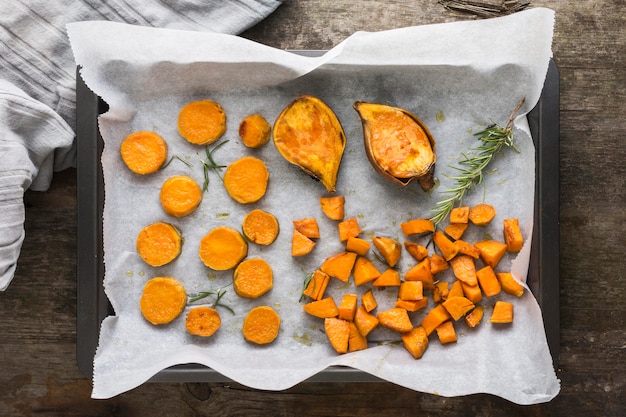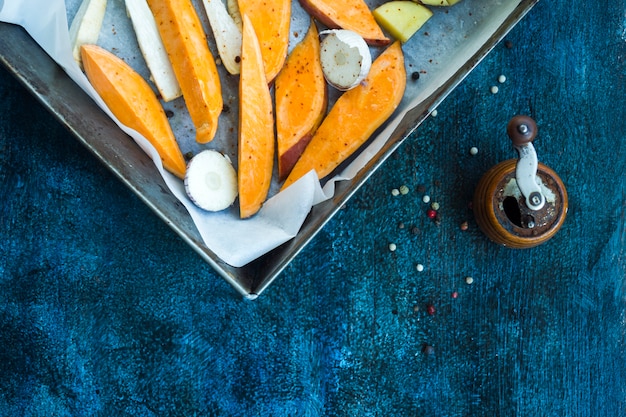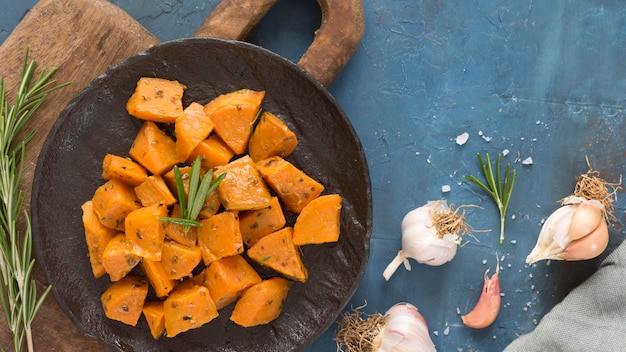(Part 1) Choosing the perfect sweet potato

Firmness and Texture
First and foremost, you want a firm, solid sweet potato. Avoid anything that feels mushy or has any signs of damage. Imagine how a perfectly ripe avocado feels - a little bit of give, but mainly firm. That's what you're aiming for.
Color and Appearance
Next, take a look at the colour. A good sweet potato will have a nice, even colour, without any green patches. Those green bits are a bit bitter, so they're not good for eating. They're a sign that the potato has been exposed to light and started to sprout, which isn't ideal for cooking.
Size and Shape
The size and shape of the sweet potato aren't as crucial as the firmness and colour, but it can influence your cooking method. For instance, a smaller sweet potato might be perfect for roasting whole, while a larger one might be best cut into wedges.
(Part 2) Getting Ready to Cook: Preparing Your Sweet Potato

Washing Away the Dirt
First, give it a good wash. You want to remove any dirt or debris, making sure it's sparkling clean. You can use a vegetable brush for a thorough clean. Think of it as giving your sweet potato a spa day before it gets cooked!
Peeling or Leaving It On? A Matter of Taste
Next, you have a choice: peel or leave the skin on? This depends on the recipe and your personal preference. For roasting, I often leave the skin on, it adds a nice bit of texture and flavour. The skin is packed with nutrients, so it's a good thing to eat. But for mashing or for a smooth puree, peeling is a good idea.
Peeling Tips
Peeling a sweet potato can be a bit tricky, especially if you've got a stubborn one. I've found the easiest way is to use a vegetable peeler. Hold the sweet potato firmly and gently glide the peeler down the length. If you're feeling brave, you can try using a sharp knife. But be careful, those sweet potatoes can be slippery.
Chopping It Up: Size Matters
Now, you've got your peeled (or unpeeled) sweet potato, ready to be chopped. If you're roasting, you can cut it into chunks or wedges. For mashing or puree, you'll want smaller pieces. If you're using a food processor, it's not so important, but if you're mashing by hand, those smaller pieces are a must.
(Part 3) The Art of Sweet Potato Cooking: Different Methods, Different Flavors

Roasting: A Classic Choice
Roasting is my go-to method for sweet potatoes. It brings out the natural sweetness and creates a wonderfully caramelized flavour. It's a simple process, too. Just preheat your oven to 200°C (400°F), toss your chopped sweet potatoes with olive oil, salt, and pepper, spread them out on a baking sheet, and bake for 30-45 minutes, or until they're tender and slightly browned.
Boiling: Quick and Easy
Boiling is a simple and quick way to cook a sweet potato, perfect for mashing or using in soups or stews. Fill a pot with water, bring it to a boil, and add your chopped sweet potatoes. Boil for 15-20 minutes, or until tender. You can tell if it's done by piercing it with a fork. If it goes in easily, it's ready! Just remember to drain the water and pat the sweet potatoes dry before using them.
Microwave: A Speedy Solution
Yes, you can even microwave a sweet potato! It's a great option if you're short on time. Simply pierce the sweet potato a few times with a fork and microwave on high for 5-7 minutes, or until tender. Just make sure to keep an eye on it, as microwave cooking times can vary depending on the wattage of your microwave.
Grilling: Adding Smoky Flavour
Grilling a sweet potato adds a smoky, char-grilled flavour that's absolutely delicious. Slice your sweet potato into ??-inch thick slices and brush them with olive oil and your favourite seasonings. Grill for 5-7 minutes per side, or until tender and slightly charred. Be careful, those grill marks can be tempting, but don't get distracted and let them burn!
Baking: Whole and Simple
Baking a sweet potato whole is a classic method that results in a soft and sweet centre. Simply prick the sweet potato a few times with a fork and bake at 180°C (350°F) for 45-60 minutes, or until tender. You can test it with a fork, if it goes in easily, it's ready. The skin will be slightly wrinkled and a bit dry.
(Part 4) Sweet Potato Cooking Time Chart: A Handy Guide
Now, let's get down to the nitty-gritty – cooking times! Remember, these are just guidelines. The actual cooking time can vary depending on the size and thickness of your sweet potato, the type of oven you're using, and even the altitude. So, always check for tenderness before you call it done.Here's a handy little table to help you out:
| Cooking Method | Size | Cooking Time |
|---|---|---|
| Roasting (Whole) | Medium | 45-60 minutes |
| Roasting (Chunks/Wedges) | Medium | 30-45 minutes |
| Boiling (Whole) | Medium | 20-25 minutes |
| Boiling (Chopped) | Medium | 15-20 minutes |
| Microwave (Whole) | Medium | 5-7 minutes |
| Grilling (Sliced) | Medium | 10-15 minutes |
| Baking (Whole) | Medium | 45-60 minutes |
(Part 5) Knowing When It's Ready: Sweet Potato doneness tests
You've got your sweet potato cooking, now how do you know when it's done? No need for guesswork. Here are a few simple, reliable tests:The Fork Test: The Classic Approach
This is my go-to method. Simply pierce the sweet potato with a fork. If it goes in easily, it's cooked. If it feels firm or meets resistance, it needs more time. This test works for all cooking methods except grilling.
The Squeeze Test: A Gentle Probe
For a whole roasted or baked sweet potato, gently squeeze it. If it feels soft and gives way to pressure, it's ready. If it's still firm, it needs more time. This test is especially useful for whole sweet potatoes.
The Visual Test: Signs of Success
If you're roasting your sweet potato, look for a golden brown colour. This means it's nicely caramelized and ready to eat. You'll also notice that the sweet potato has softened slightly. The skin will be slightly wrinkled.
Don't Be Afraid to Check Early
Remember, it's always better to check a little early than to overcook your sweet potato. It's much easier to add a few minutes of cooking time than to try to salvage an overcooked sweet potato.
(Part 6) sweet potato recipes: Endless Possibilities
Now, let's talk about what you can do with your perfectly cooked sweet potato. There are endless possibilities, from simple side dishes to hearty main courses. Here are a few of my favourites:mashed sweet potato: A Creamy Classic
A classic comfort food, mashed sweet potato is easy to make and incredibly delicious. Simply boil or roast your sweet potato, then mash it with a fork or potato masher. Add some butter, salt, and pepper for extra flavour. You can also add a little milk or cream for a creamier consistency. To give it a little extra sweetness, a drizzle of maple syrup or honey is perfect.
sweet potato fries: Crispy and Delicious
These are a popular choice for a delicious and healthy snack or side dish. Cut your sweet potato into thin fries and toss them with olive oil, salt, and pepper. Bake them in a preheated oven at 200°C (400°F) for 20-25 minutes, or until they're crispy. You can also try dipping them in your favourite sauce, like ketchup, sriracha mayo, or a creamy avocado dip.
sweet potato curry: Flavourful and Satisfying
Sweet potato curry is a flavourful and satisfying meal. Roast or boil your sweet potato, then add it to a pot of your favourite curry sauce. Add other vegetables, like chickpeas, spinach, or cauliflower, for a more balanced meal. Serve it with rice or naan bread.
Sweet potato soup: Warm and Comforting
A warm and comforting soup, sweet potato soup is perfect for a chilly day. Roast or boil your sweet potato, then blend it with vegetable broth, coconut milk, and spices. Add a dollop of sour cream or yogurt on top for a finishing touch. For a richer flavour, use a combination of vegetable broth and coconut milk.
(Part 7) Storing Your Sweet Potatoes: Keeping Them Fresh and Delicious
You've cooked your perfect sweet potato, but now what? It's important to store them properly to keep them fresh and delicious. Here are a few tips:Storing Uncooked Sweet Potatoes
Uncooked sweet potatoes should be stored in a cool, dark, and dry place. Avoid storing them in the refrigerator, as the cold can cause them to become sweeter and softer. A pantry or cupboard is a good option. It's also a good idea to keep them separate from other fruits and vegetables, especially apples and bananas, as they emit ethylene gas that can speed up ripening.
Storing Cooked Sweet Potatoes
Cooked sweet potatoes can be stored in the refrigerator for up to 3-4 days. Make sure they're stored in an airtight container to prevent them from drying out. You can also freeze cooked sweet potatoes for up to 3 months. Just make sure to cool them completely before freezing. To use frozen sweet potato, thaw it overnight in the refrigerator and then proceed with your recipe.
(Part 8) sweet potato health benefits: A Nutritious Treat
Sweet potatoes are not only delicious but also packed with nutrients. They're a good source of:- Vitamin A: Supports healthy vision and skin. Sweet potatoes are an excellent source of beta-carotene, which the body converts to vitamin A. It's essential for healthy vision, skin, and immune function.
- Vitamin C: Boosts the immune system. Sweet potatoes contain vitamin C, an antioxidant that helps protect cells from damage. It also plays a role in immune function, collagen production, and wound healing.
- Fiber: Promotes digestive health. Sweet potatoes are a good source of dietary fibre, which is important for digestive health. It helps regulate bowel movements, adds bulk to stools, and promotes a healthy gut microbiome.
- Potassium: Helps regulate blood pressure. Sweet potatoes contain potassium, an essential mineral that plays a role in muscle function, blood pressure regulation, and fluid balance.
- Antioxidants: Protect cells from damage. Sweet potatoes contain a range of antioxidants, including beta-carotene, vitamin C, and anthocyanins. Antioxidants protect cells from damage caused by free radicals, which are unstable molecules that can contribute to aging and disease.
(Part 9) FAQs: Common Questions Answered
Q: How can I tell if a sweet potato is ripe?
A: A ripe sweet potato will feel firm to the touch and have a smooth, even skin. Avoid any that are soft, wrinkled, or have any signs of damage. A good sign is a slight give when you gently press on it, similar to a ripe avocado.
Q: Can I eat the skin of a sweet potato?
A: Yes, the skin of a sweet potato is edible and contains fibre and nutrients. However, if you're not used to eating the skin, it can be a bit tough. You can always peel it if you prefer. If you're roasting the sweet potato, the skin will often become crispy and enjoyable to eat.
Q: What happens if I overcook a sweet potato?
A: An overcooked sweet potato will be mushy and may have a slightly bitter taste. It's best to check for tenderness regularly to avoid overcooking. You can also tell by the color of the sweet potato. If it's very dark brown or black, it's likely overcooked.
Q: Can I use sweet potato in place of regular potato in recipes?
A: Yes, you can use sweet potato in place of regular potato in many recipes. However, it will have a sweeter flavour and a slightly softer texture. Adjust the amount of sugar or other sweeteners accordingly. You may also need to adjust the cooking time, as sweet potatoes tend to cook a bit faster than regular potatoes.
Q: Can I freeze sweet potato?
A: Yes, you can freeze cooked sweet potato for up to 3 months. Simply cool it completely before freezing. To use frozen sweet potato, thaw it overnight in the refrigerator and then proceed with your recipe. You can also freeze cooked sweet potatoes mashed with a little butter or milk. This is a great way to have a quick and easy meal or snack on hand.
Everyone is watching

Corn on the Cob: The Ultimate Guide to Perfectly Cooked Ears
Healthy MealsAh, corn on the cob. Just the name evokes images of sunny days, barbecues, and that sweet, juicy flavour that ...

Perfect Pork Roast Oven Cooking Time: A Guide to Delicious Results
Healthy MealsThere's something truly satisfying about a perfectly roasted pork. The aroma alone is enough to make your mout...

Ham Cooking Time: How Long to Bake, Smoke, or Boil a Delicious Ham
Healthy MealsAh, ham. It's a classic, isn't it? A real crowd-pleaser, especially around holidays. And when done right, it'...

Scallops: The Ultimate Guide to Perfect Cooking
Healthy MealsAh, scallops. Those delicate, sweet, and utterly delicious morsels of the sea. They hold a special place in my...

Spaghetti Squash: The Ultimate Guide to Cooking and Serving
Healthy MealsRemember that time you saw spaghetti squash at the supermarket, looking all bumpy and strange, and thought, "W...
